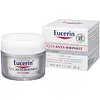What's inside
What's inside
 Key Ingredients
Key Ingredients

 Benefits
Benefits

 Concerns
Concerns

 Ingredients Side-by-side
Ingredients Side-by-side

Water
Skin ConditioningGlycerin
HumectantOctyldodecanol
EmollientSqualane
EmollientButyrospermum Parkii Butter
Skin ConditioningSimmondsia Chinensis Seed Oil
EmollientCaprylic/Capric Triglyceride
MaskingLactococcus Ferment Lysate
Skin ConditioningPolyglyceryl-2 Stearate
EmulsifyingGlyceryl Stearate
EmollientMicrocrystalline Cellulose
AbsorbentStearic Acid
CleansingStearyl Alcohol
EmollientFucose
Skin ConditioningTocopheryl Acetate
AntioxidantLactic Acid
BufferingPalmitic Acid
EmollientCellulose Gum
Emulsion StabilisingXanthan Gum
EmulsifyingCitric Acid
BufferingSodium Chloride
MaskingParfum
MaskingPhenoxyethanol
PreservativeSodium Benzoate
MaskingWater, Glycerin, Octyldodecanol, Squalane, Butyrospermum Parkii Butter, Simmondsia Chinensis Seed Oil, Caprylic/Capric Triglyceride, Lactococcus Ferment Lysate, Polyglyceryl-2 Stearate, Glyceryl Stearate, Microcrystalline Cellulose, Stearic Acid, Stearyl Alcohol, Fucose, Tocopheryl Acetate, Lactic Acid, Palmitic Acid, Cellulose Gum, Xanthan Gum, Citric Acid, Sodium Chloride, Parfum, Phenoxyethanol, Sodium Benzoate
Water
Skin ConditioningGlycerin
HumectantEthylhexyl Cocoate
EmollientHydrogenated Coco-Glycerides
EmollientStearyl Alcohol
EmollientButylene Glycol
HumectantCetyl Alcohol
EmollientCaprylic/Capric Triglyceride
MaskingButyrospermum Parkii Butter
Skin ConditioningGlyceryl Stearate Citrate
EmollientOctyldodecanol
EmollientTocopheryl Acetate
AntioxidantUbiquinone
AntioxidantBiotin
AntiseborrhoeicBiosaccharide Gum-1
HumectantSodium Ascorbyl Phosphate
AntioxidantZea Mays Oil
EmulsifyingBeta-Carotene
Skin Conditioning1,2-Hexanediol
Skin ConditioningCarbomer
Emulsion StabilisingSodium Hydroxide
BufferingTrisodium EDTA
Dehydroacetic Acid
PreservativePhenoxyethanol
PreservativeWater, Glycerin, Ethylhexyl Cocoate, Hydrogenated Coco-Glycerides, Stearyl Alcohol, Butylene Glycol, Cetyl Alcohol, Caprylic/Capric Triglyceride, Butyrospermum Parkii Butter, Glyceryl Stearate Citrate, Octyldodecanol, Tocopheryl Acetate, Ubiquinone, Biotin, Biosaccharide Gum-1, Sodium Ascorbyl Phosphate, Zea Mays Oil, Beta-Carotene, 1,2-Hexanediol, Carbomer, Sodium Hydroxide, Trisodium EDTA, Dehydroacetic Acid, Phenoxyethanol
Ingredients Explained
These ingredients are found in both products.
Ingredients higher up in an ingredient list are typically present in a larger amount.
This ingredient is also known as shea butter. It is an effective skin hydrator and emollient.
Emollients help soothe and soften your skin. It does this by creating a protective film on your skin. This barrier helps trap moisture and keeps your skin hydrated. Emollients may be effective at treating dry or itchy skin.
Shea butter is rich in antioxidants. Antioxidants help fight free-radicals, or molecules that may harm the body. It is also full of fatty acids including stearic acid and linoleic acid. These acids help replenish the skin and keep skin moisturized.
While Shea Butter has an SPF rating of about 3-4, it is not a sunscreen replacement.
Shea butter may not be fungal acne safe. We recommend speaking with a professional if you have any concerns.
Learn more about Butyrospermum Parkii ButterThis ingredient is an emollient, solvent, and texture enhancer. It is considered a skin-softener by helping the skin prevent moisture loss.
It helps thicken a product's formula and makes it easier to spread by dissolving clumping compounds.
Caprylic Triglyceride is made by combining glycerin with coconut oil, forming a clear liquid.
While there is an assumption Caprylic Triglyceride can clog pores due to it being derived from coconut oil, there is no research supporting this.
Learn more about Caprylic/Capric TriglycerideGlycerin is already naturally found in your skin. It helps moisturize and protect your skin.
A study from 2016 found glycerin to be more effective as a humectant than AHAs and hyaluronic acid.
As a humectant, it helps the skin stay hydrated by pulling moisture to your skin. The low molecular weight of glycerin allows it to pull moisture into the deeper layers of your skin.
Hydrated skin improves your skin barrier; Your skin barrier helps protect against irritants and bacteria.
Glycerin has also been found to have antimicrobial and antiviral properties. Due to these properties, glycerin is often used in wound and burn treatments.
In cosmetics, glycerin is usually derived from plants such as soybean or palm. However, it can also be sourced from animals, such as tallow or animal fat.
This ingredient is organic, colorless, odorless, and non-toxic.
Glycerin is the name for this ingredient in American English. British English uses Glycerol/Glycerine.
Learn more about GlycerinOctyldodecanol is a fatty alcohol. It is primarily used to enhance the texture of products.
As an emulsifier, Octyldodecanol helps prevent the oils and waters from separating. It also prevents ingredients from creating foam when shaken.
Octyldodecanol is created by reducing fatty acid to an alcohol.
Due to its high molecular weight, it does not get absorbed into the skin.
Learn more about OctyldodecanolPhenoxyethanol is a preservative that has germicide, antimicrobial, and aromatic properties. Studies show that phenoxyethanol can prevent microbial growth. By itself, it has a scent that is similar to that of a rose.
It's often used in formulations along with Caprylyl Glycol to preserve the shelf life of products.
Stearyl Alcohol is a type of fatty alcohol from stearic acid. It is a white, waxy compound used to emulsify ingredients.
Fatty Alcohols are most often used as an emollient or to thicken a product. Emollients help soothe and hydrate the skin by trapping moisture.
They are usually derived from natural fats and oils and therefore do not have the same drying or irritating effect as solvent alcohols. FDA allows products labeled "alcohol-free" to have fatty alcohols.
Learn more about Stearyl AlcoholTocopheryl Acetate is AKA Vitamin E. It is an antioxidant and protects your skin from free radicals. Free radicals damage the skin by breaking down collagen.
One study found using Tocopheryl Acetate with Vitamin C decreased the number of sunburned cells.
Tocopheryl Acetate is commonly found in both skincare and dietary supplements.
Learn more about Tocopheryl AcetateWater. It's the most common cosmetic ingredient of all. You'll usually see it at the top of ingredient lists, meaning that it makes up the largest part of the product.
So why is it so popular? Water most often acts as a solvent - this means that it helps dissolve other ingredients into the formulation.
You'll also recognize water as that liquid we all need to stay alive. If you see this, drink a glass of water. Stay hydrated!
Learn more about Water